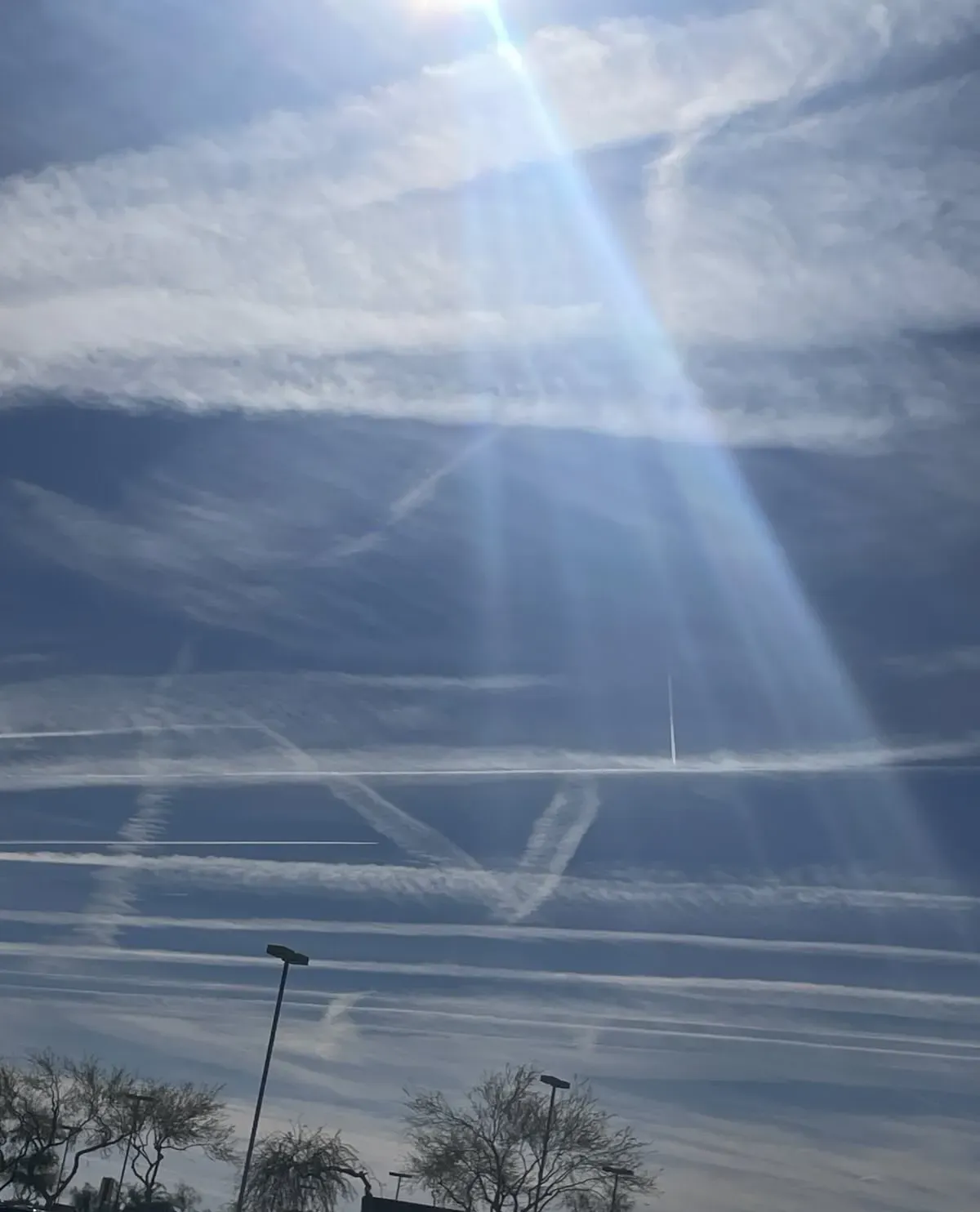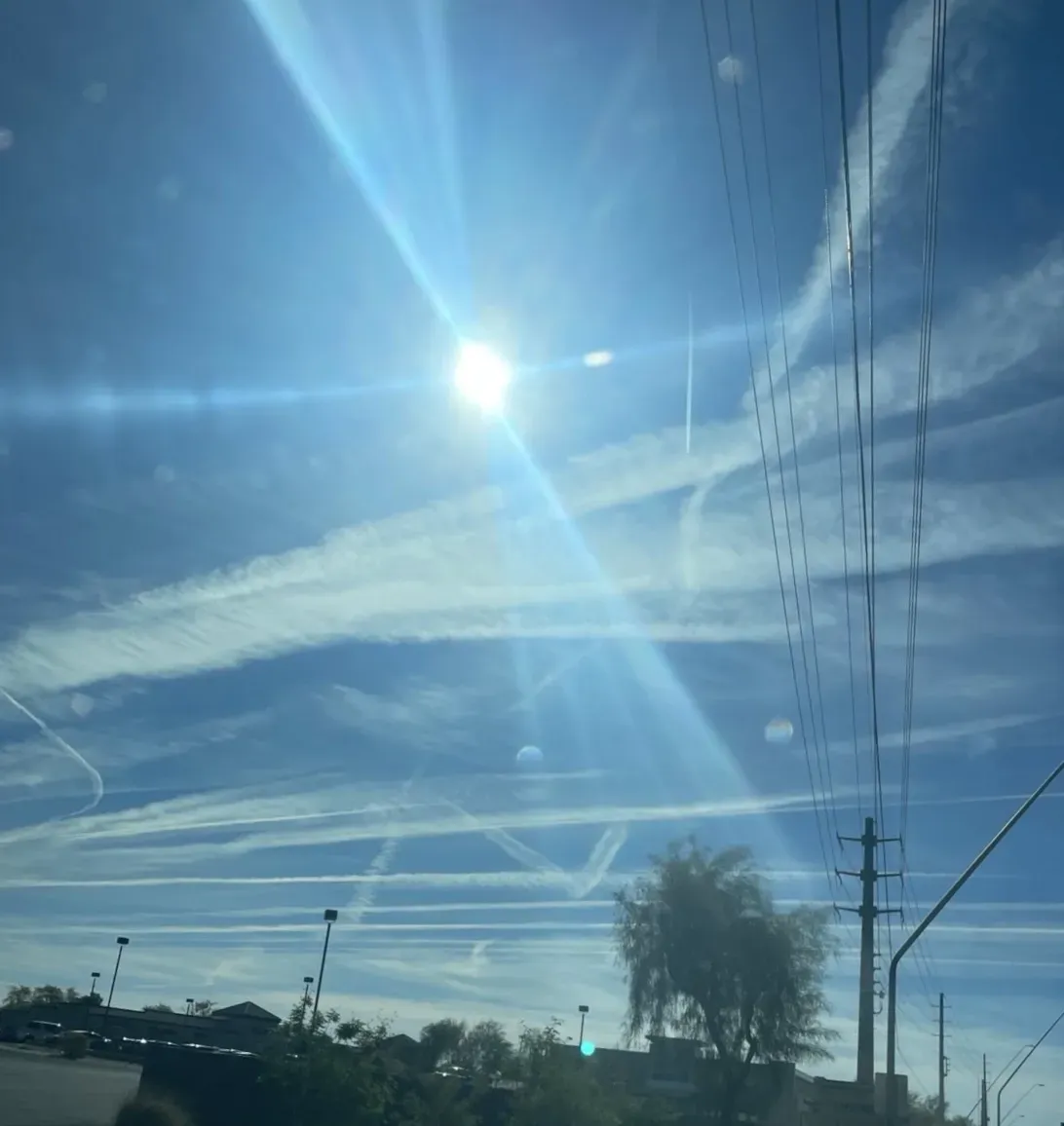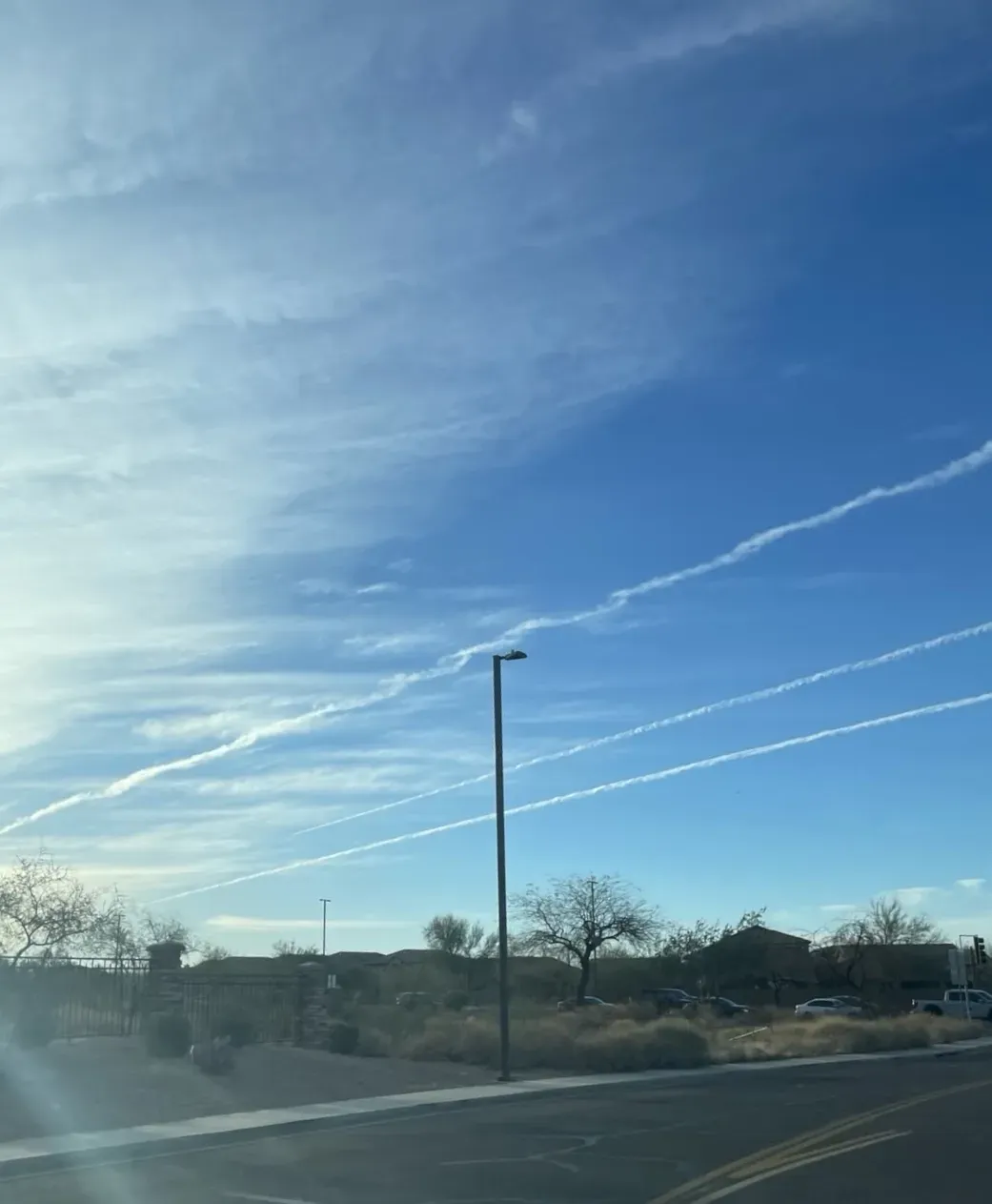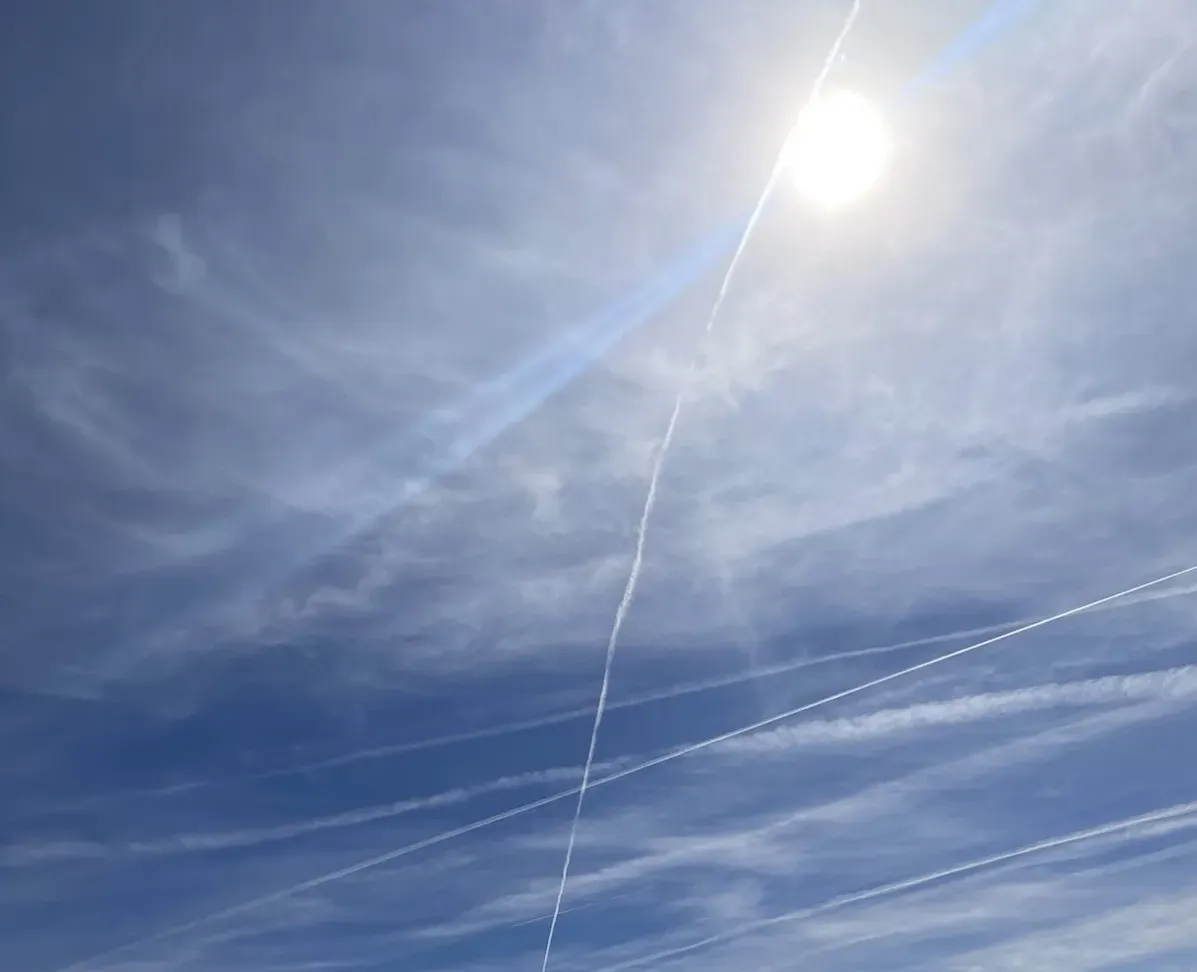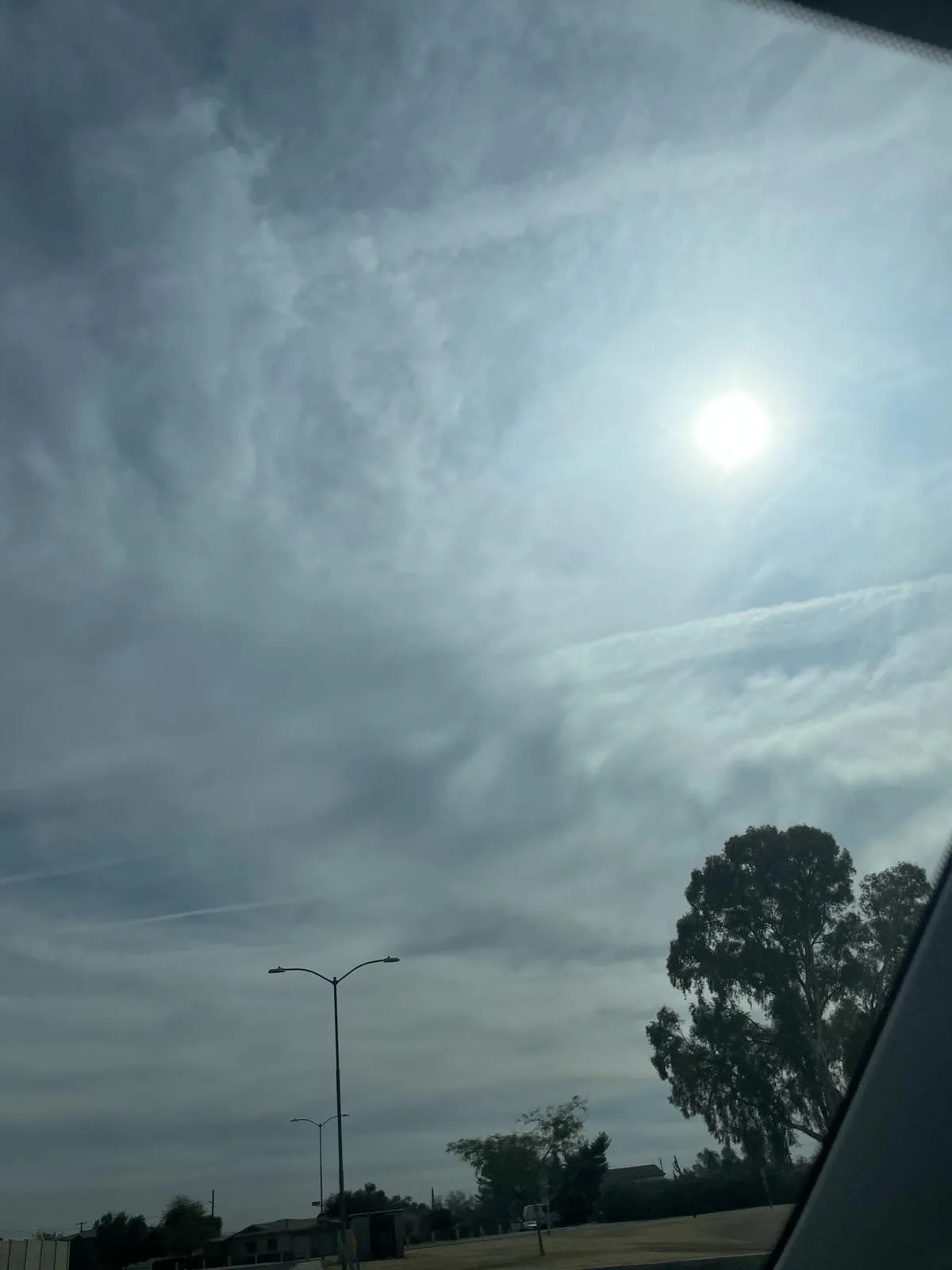One Sky. One Voice. One Movement
Your Courage Can Inspire Change
How one woman helped Arizona spark it's first Geoengineering Prohibition Bill
Hi, I’m Jodi Brackett, and I sparked the creation of Arizona's first Geoengineering Prohibition Bill: HB2056.
In early 2023, I noticed something unusual: long, aggressive white lines streaking across our skies. These lines didn’t fade like normal clouds.
Day after day, I watched them spread until the sunlight itself seemed dimmed. I couldn’t shake the feeling that something wasn’t right.
I watched closely, taking pictures and videos, and filled my calendar with notes describing what the sky looked like each day. The more I observed, the more I realized that this wasn’t natural. It felt intentional, as if the sun itself was being covered on purpose.
I learned that this practice is called Solar Radiation Modification (SRM). That discovery lit a fire in me. I sent photos and messages to legislators almost every day, urging them to take action.
Representative Lisa Fink finally answered, and listened when others didn’t. Because of her courage, Arizona took its first stand for clear, honest skies.
Together, we brought forward House Bill 2056, Arizona’s first-ever Geoengineering Prohibition Act. That moment marked the beginning of real accountability and awareness. HB2056 didn't pass, but it proved that one voice can start a movement.
Have You NoticED?
something isn’t right with our skies
Once known for its bright, sunny days, Arizona is now increasingly blanketed by unnatural cloud cover. Lines and haze intentionally left behind by jets, spreading until the sun disappears behind a murky veil. No agency claims responsibility. No clear answers are given. But the effects are impossible to ignore.
Blue Skies 4 AZ was founded by ordinary people. Athletes, parents, professionals, who decided enough is enough. We’re here to educate, unite, and take action against the unregulated and unacknowledged practice of solar radiation management (SRM) and stratospheric aerosol injections (SAIs), often referred to as geoengineering.
What began as quiet concern has grown into a movement. One of our founders, a longtime triathlete, recalls how the skies used to be — clear, predictable, alive. But during Thanksgiving week of 2024, the transformation became undeniable. The sky would start off clear, then become crosshatched by aircraft trails until the sun was dimmed by a gray canopy. "They should do something about this."

“I felt like a bug being exterminated. That’s when I realized I am the ‘they’ I’d been waiting for.”
From that moment on, we’ve worked tirelessly with local representatives, pushed for legislation, and built a network of informed, committed citizens. Though our first bill failed, our resolve has only grown stronger.
HB2056: The First Breakthrough in Arizona’s
Fight Against Geoengineering
Every big movement starts with a first step, and for Arizona, that step was House Bill 2056.
HB2056 clears its first hurdle in House Oversight
First hearing of HB2056, Rep. Lisa Fink’s geoengineering prohibition bill, which
passed House Regulatory Oversight on 1/28/25.
HB2056 was the spark. It showed what’s possible when representatives and citizens push together for transparency, accountability, and the right to have a say in what happens in our skies.
Sponsored by Representative Lisa Fink, HB2056 was the state’s first attempt to put a stop to geoengineering practices like cloud seeding and solar radiation management (SRM). For many Arizonans, this bill represented something powerful: their concerns finally being voiced at the Capitol.
On January 28, 2025, that voice was heard.
HB2056 went before the House Regulatory Oversight Committee - and it passed.
That moment mattered. In a legislative system where so many bills are killed before they ever see daylight, HB2056 broke through the silence. It proved that the issue of geoengineering wasn’t too fringe, too complicated, or too controversial to move forward. It proved lawmakers were willing to listen.
From there, the bill was also assigned to the House Natural Resources Committee, where it unfortunately stalled. But let’s not overlook the victory: HB2056 became the first geoengineering prohibition bill in Arizona history to advance out of a House committee.
SB1432: A Landmark Step
Toward Accountability in Arizona’s Skies
For those who doubt whether citizen voices can make a difference, look no further than Senate Bill SB1432.
SB1432 Advances Senate Natural ResourCES Committee
SB1432 SRM prohibition bill passed Senate Natural Resources Committee
Supporters should take heart. SB1432 was not a defeat, it was a breakthrough. And breakthroughs don’t just disappear. They create the foundation for the next fight, the next session, and the next victory.
SB1432 showed us what’s possible. Now it’s up to all of us to make sure the next bill doesn’t just pass the Senate, but becomes law.
Introduced by Senator David Farnsworth, SB1432 set out to prohibit controversial solar radiation management (SRM) practices in Arizona.
This wasn’t just a symbolic effort. The bill had substance, clarity, and the backing of Arizonans who believe the public deserves a say in environmental decisions that directly affect their health and skies.
On February 18, 2025, SB1432 received its first hearing before the Senate Natural Resources Committee.
The bill didn’t just get heard. It passed.
From there, it advanced to the Senate floor, where legislators once again gave their approval.
The Senate passed SB1432.On 03/18/2025, SB1432 was passed by the House Regulatory Oversight Committee
This was the furthest any geoengineering prohibition bill has advanced in Arizona to date.
SB1432 was ultimately stalled when it reached the House Natural Resources Committee, where no hearing was scheduled. But that doesn’t erase its achievement. If anything, it proves that real momentum is building. A geoengineering ban bill didn’t just survive committee; it earned the support of the full Senate.
That matters. And it tells us that:
The issue is being taken seriously.
Lawmakers are listening.
And with continued grassroots involvement, Arizona is closer than ever to enacting real protections.
The Sting of Climate Intervention
Over the past eight months, U.S. beekeepers have experienced catastrophic losses, some reporting over 60% of their honeybee colonies gone. That’s millions of pollinators vanished, marking one of the worst seasons on record.
A Silent Collapse:
Where Are the Bees?
As climate intervention strategies grow more aggressive, experts caution that disrupting one system can unbalance another. The bee crisis may be more than just a warning, it might be a symptom of unintended consequences.
While pesticides, parasites, and habitat loss are well-known contributors, scientists are also investigating broader environmental stressors, including the potential side effects of geoengineering.
Geoengineering, such as stratospheric aerosol injection (SAI), is designed to cool the planet by dispersing reflective particles like aluminum, barium, or sulfur into the atmosphere. But these particles may settle into soil and water, potentially affecting plant health and pollinator behavior
Congress Grills Weather Modification and
Climate Engineering Efforts
Playing God with the Weather
A Disastrous Forecast
A recent congressional subcommittee hearing turned the spotlight on one of the most controversial environmental topics of our time: weather modification and geoengineering.
Lawmakers and scientists debate weather modification and climate engineering in Sept. 2025 hearing.
What makes today’s conversation different is scale. Instead of simply trying to end a drought, geoengineering proposals aim to reshape the global climate. Methods include removing carbon dioxide from the air or injecting reflective aerosols into the atmosphere to block sunlight. Critics warned these approaches could trigger catastrophic side effects—crop failures, ozone depletion, acid rain, or even disruptions to ecosystems and human health.
Lawmakers, scientists, and policy experts debated whether attempts to manipulate the weather, or even the global climate, are scientific progress or reckless experiments with life on Earth.
The hearing revealed sharp partisan divides.
Republican members raised alarms over government-backed climate engineering, comparing it to “playing God” with the weather. They highlighted past government experiments such as Project Stormfury and Operation Popeye, warning that large-scale geoengineering could be dangerous and ripe for abuse.
Democratic members emphasized the urgency of addressing climate change, noting decades of evidence linking carbon emissions to rising global temperatures, droughts, and floods. They argued that careful regulation, not conspiracy theories, should guide the nation’s response.
For now, the message from experts was clear: the science is uncertain, the risks are high, and the need for public accountability is greater than ever.
Federal and State Efforts Target Climate Manipulation
Efforts to regulate weather modification have surfaced at both state and federal levels. Earlier this month, Representative Marjorie Taylor Greene (R-Ga.) announced plans to introduce a bill that would make it illegal to release or inject substances into the atmosphere with the intent of changing weather, climate, temperature, or sunlight levels.
🚨 BREAKING: CLEAR SKIES ACT INTRODUCED ☀️ I just introduced the Clear Skies Act to BAN geoengineering and weather modification. No more spraying chemicals in our skies. It’s time to end this dangerous and unregulated practice.
Posted by Congresswoman Marjorie Taylor Greene on Tuesday, July 15, 2025
“I’m glad weather modification and geoengineering are finally getting the attention and transparency they deserve, and I’m greatly appreciative to the Trump Administration for it.”
- Marjorie Taylor Greene
“This will be a felony offense,” Greene stated, explaining that the proposed legislation mirrors a similar law already enacted in Florida. “I’ve been researching weather modification and working with legislative counsel for months writing this bill.”
In a separate discussion last August, Health and Human Services Secretary Robert F. Kennedy Jr. responded to a viral video that showed what some believed to be atmospheric spraying. Kennedy described it as a “crime” he intended to “stop.”
During a town hall event on April 29, 2025, hosted by Dr. Phil McGraw, Kennedy also mentioned concerns involving the Defense Advanced Research Projects Agency (DARPA). He suggested that materials such as bromium, aluminum, and strontium might be present in jet fuel, saying, “A lot of it now is coming out of the jet fuel… I’m going to do everything in my power to stop it.”
Meanwhile, environmental concerns have also been raised within federal agencies. In a public statement, EPA official Lee Zeldin noted, “EPA shares many of the same concerns when it comes to potential threats to human health and the environment, especially from solar geoengineering activities.” He added, “Prior to now, EPA has never been this proactive to raise awareness about concerns with geoengineering and to stop this activity from being scaled up.”
AZ Legislation: What We’ve Learned
Sometimes progress in Arizona’s legislature does not end with a vote or debate. Sometimes a bill simply never reaches the hearing stage. It may not make headlines, but it highlights how important persistence and education are in creating lasting change.
Earlier this year, two bills: HB2056 (sponsored by Rep. Lisa Fink) and SB1432 (sponsored by Sen. David Farnsworth), aimed to bring transparency and accountability to atmospheric and weather modification practices. Their purpose was simple: to make sure the public has a voice and access to information about activities that affect our skies.
Although these measures did not advance this time, they achieved something meaningful.
They sparked a statewide conversation about transparency, environmental accountability, and public participation.
Thousands of Arizonans got involved, showing that this issue matters deeply to our communities.
Each legislative session gives us a new opportunity to refine our approach, build understanding, and strengthen relationships with decision makers. Real progress happens through education, outreach, and steady collaboration, not confrontation.
We are grateful to every lawmaker who listened and asked questions, and to every Arizonan who took the time to engage. Together we are building awareness, encouraging thoughtful dialogue, and moving Arizona closer to a transparent and accountable future.
From the Frying Pan Into the Fire
In a compelling episode of Back to the People, lead researcher and founder of GeoengineeringWatch.org, Dane Wigington joins Nicole Shanahan to share his journey from sustainable living advocate to whistleblower on covert climate engineering practices.
Back to the People Podcast
By manipulating Earth’s climate via scattering particles to block sunlight or sucking carbon from the air, it gambles with nature’s delicate balance, inviting consequences we can’t possibly predict.
After observing a significant drop in his solar panels' efficiency and discovering toxic levels of aluminum in rainwater, Wigington began investigating the potential link to solar radiation management (SRM) programs. He argues that these initiatives, intended to mitigate climate change by reflecting sunlight, may be causing unintended environmental harm, including soil degradation and forest decline.
Wigington warns that such geoengineering efforts could be exacerbating the very issues they aim to solve, pushing us "from the frying pan into the fire."
We Need Leaders Who Protect Arizona’s Skies
Leaders like Representative Lisa Fink and Senator David Farnsworth give us reason to hope. They remind us what true public service looks like: listening, representing, and standing up for the people they serve, even when it is not the easy path.
In 2024, they introduced Arizona’s first bills to address weather modification and geoengineering practices. Their efforts marked a turning point in recognizing that transparency and public involvement belong at the center of environmental decision making.
HB2056, sponsored by Rep. Fink, focused on preventing unapproved atmospheric activities such as cloud seeding and solar radiation management.
SB1432, sponsored by Sen. Farnsworth, strengthened the language to ensure accountability for anyone releasing materials into Arizona’s atmosphere.
Together, these bills expressed a simple but powerful idea: Arizonans deserve to know what is being done in their skies and to have a say in it.
Both measures gained meaningful traction. SB1432 passed the Senate. HB2056 passed the House Regulatory Oversight Committee. Each success proved that this issue resonates far beyond politics. It reflects a shared value among lawmakers and citizens who care about health, safety, and accountability.
Although the bills did not advance further this session, their introduction sparked awareness, dialogue, and engagement. Every conversation, hearing, and vote brings Arizona one step closer to the open and transparent process that our communities deserve.
Arizona needs more leaders who are willing to continue that work, to listen, to learn, and to stand for the simple belief that the people should always have a voice in what happens above their heads.
Examples of GeoEngineering

